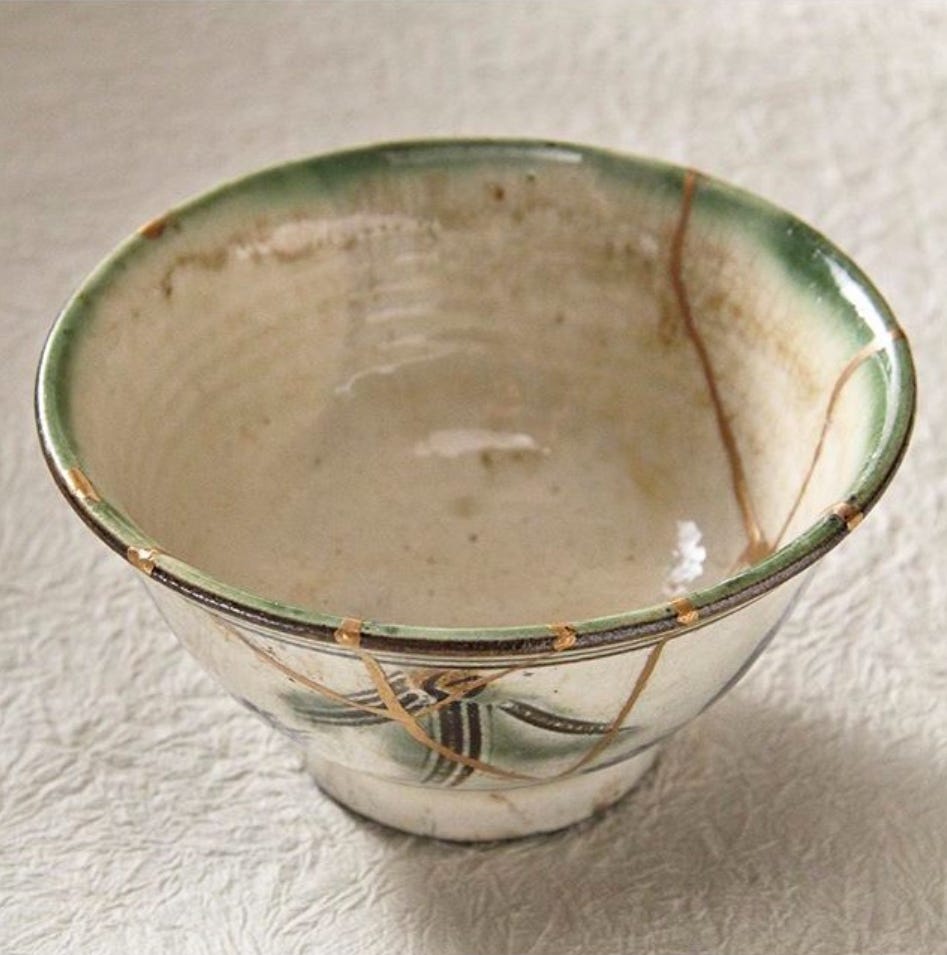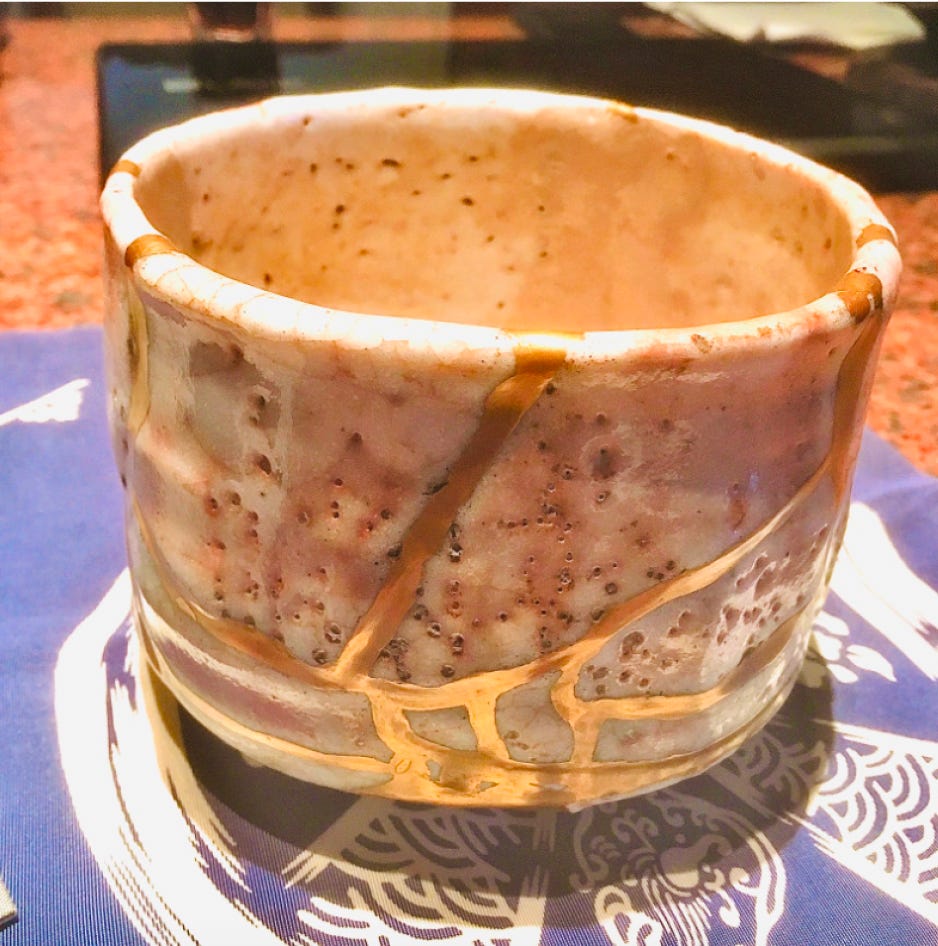This is a bonus piece I wrote for my book “Learn, Improve, Master.” It’s an interview with a Kintsugi master about his art and his views on learning and mastery.
A Short History of Kintsugi
In 16th-century Japan, tea bowls became as coveted as land. Shogun Oda Nobunaga had taken control of most of Honshu (Japan’s main island), and in an unprecedented move, he restricted the tea ceremony (a Japanese cultural activity) to only those he granted permission—and conducting the ceremony without it was punished by death.
After elevating the status of the tea ceremony and making it an aspiring right of the elite, Nobunaga stopped granting land to high members of society and instead rewarded them with tea bowls and accessories, which represented the right to conduct the prestigious ceremony.
With Nobunaga’s move, tea bowls turned into a symbol of status and power for feudal lords, wealthy merchants, and military leaders—and became as coveted as land. These delicate bowls, however, would sometimes fall and break, leaving their owners with their most prized possession in pieces.
The broken bowl owners turned to Maki-e artists for help (Maki-e is the art of gold sprinkling on urushi, lacquer made from a tree of the same name). The artists transposed their skill to do the reparation, using the urushi as glue to bind the broken pieces and the gold to decorate and showcase the bindings. This new application of their art gave birth to Kintsugi (Kin=Gold, Tsugi=bind).

Kintsugi embodies one of the most beautiful concepts in Japanese philosophy, Wabi-sabi: finding beauty in imperfection, incompleteness, and inevitable decay. In the hands of an artist, Wabi-sabi is about revering transience and flaws. It’s the reason Kintsugi moves away from concealing bindings and instead showcases them. The art strives to make artifacts better for having been broken.
Kintsugi gives us a profound philosophy for life: That the painful experiences we go through can make us better and that we should honor our scars because there is beauty in them, not in spite of them.
Historically, in Japan, there weren’t Kintsugi artisans; the craft was part of Maki-e. Today, however, Kintsugi’s rising popularity is turning it into an independent art. Practitioners are breaking away from Maki-e and embracing new techniques. Select artists, however, continue the tradition and original purpose of Kintsugi that started in the 16th century (repairing valuable tea ceremony artifacts with Maki-e techniques).
One such artist is Showzi Tsukamoto, a renowned Maki-e and Kintsugi master (involved in both arts for over five decades). Tsukamoto-san collects broken artifacts from the Edo period and turns them into Kintsugi masterpieces, often displayed in museums and art galleries around the world.
I had the incredible opportunity to learn Kintsugi techniques from him over a few days. More than learning the basics of Kintsugi, I was interested in seeing him work, and get a taste of how he taught the art. During my time with him, I got to ask him a few questions about his craft, his journey, and his view on mastery. Here are his thoughts.
Q: How has your perspective of the art evolved over the past five decades?
A: In the beginning, you are expanding your mind, growing, opening up to new ideas, and gathering as much as you can. But over the years, you start narrowing down. In other words, early on, you are expanding, and in the later stages, you are contracting. With time, you zero in on what’s important and what matters most to you, the type of art you want to create, and where you focus your efforts.
Q: Were there times you wanted to quit?
A: I don’t remember ever wanting to quit, but I do remember many times when learning the art was difficult. I wasn’t good at it at the beginning, so it took me a lot of hard work to develop my skills. Even if you like what you do, it won’t always be easy, but you have to stick with it.
Q: How do you feel about your art now?
A: I love it as much as I did early on, maybe even more. Not a moment goes by that I’m not thinking about my art. I work at it every day, and every day I’m excited about it. This is the most enjoyable time in my career because I have the freedom to do art for myself. Before, I had to make art for others—and try to please them—to make a living. All the art I do now, I do it for myself. I can create anything I want, and only work on what I enjoy.
Q: What keeps you motivated?
A: I dream of new pieces all the time; I have too many ideas. I worry that I won’t be able to make them all. I wish I could live long enough to make everything that I envision. So, every day I’m excited about my art because I get to work on materializing those dreams.
Q: You see a lot of students come and go. What are the characteristics of the ones who last and the ones who don’t?
A: Perseverance. Sometimes, you see students who show talent at the beginning but lack discipline. They don’t get far. On the other side, you see students that have a tough time, it doesn’t come easy to them, but they stick with it and improve a lot. This is a long journey, just learning the art takes about six years, you can’t tell how far someone will go only by early show of talent. So, as a teacher, I also have to encourage and be patient with those who have a harder time. You don’t know what they are capable of in the long term if they keep working hard.
Q: What does mastery mean to you?
A: Mastery is being able to materialize your ideas as accurately as possible. In other words, having the ability to turn your visions into reality.





